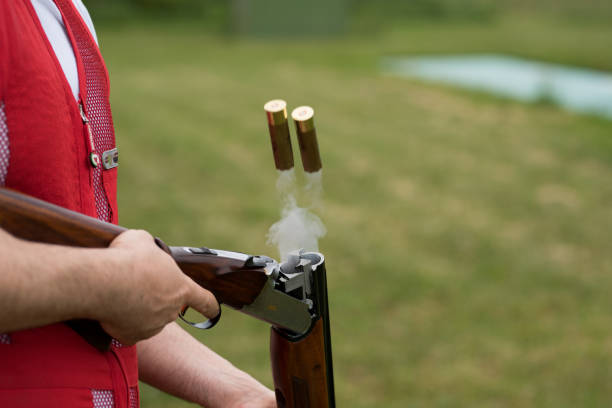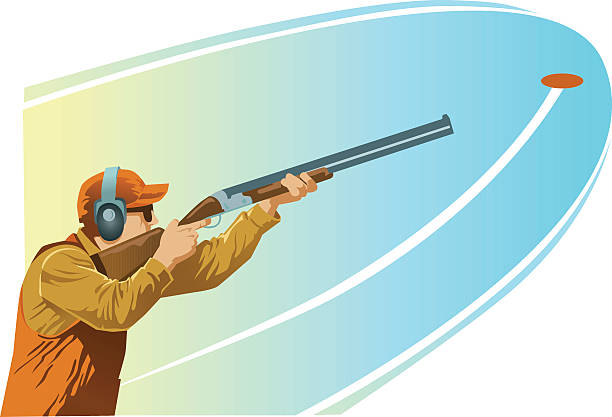What’s the Difference Between Trap and Skeet?
Shooting sports have somehow managed to soar to great heights over the years, bringing to their fold people from various backgrounds. Of the different disciplines, trap, and skeet shooting are the most notable examples of shotgun sports, which happen to be distinct and thrilling.
For beginners in shooting, understanding the difference between skeet and trap is vital. We will cover the query: What’s the Difference Between Trap and Skeet Shooting? Let’s find out.

Origins and Evolution:
To distinguish between trap and skeet shooting, we need to look at their origins. English trap shooting dates back to the late 18th century as a way of working up to bird hunting practice. As this sport gained popularity, it developed into a standardized discipline based on specific rules and regulations.
While skeet shooting was born in the early 20th century in the U.S., clay started to be used for sports in the 19th century. The skeet is a difficult target ball to fly at random, but the skeet was developed by Charles Davis, a Massachusetts grouse hunter, as an alternative to trap shooting. Through time, both of these sports have changed, with each carving its special niche, which the shooting community embraces.
“What is the difference between Trap and Skeet in Design?”
This can be easily seen in the way the trap and skeet sports are set up on the field. Trap shooting always happens on one field, where the shooters are positioned behind and in front of one trap house. The clay targets at the trap house get released at different angles and trajectory patterns, which force the shooters to be able to adjust to the changing targets’ movement direction and hit them.
Differently, skeet shooting requires tactics that are complex in the field. Skeet fields are designed in such a way that the trap houses opposite each other are located on the semicircle, i.e., parallel to the ground. Shooters follow one another at shooting bays that have been arranged in a half-moon shape and shoot at the targets out of trap houses that have shuffled their release. In context with the changing angles and distances, the dynamic character of skeet shooting is made out.
Also Read:
- What is the Difference Between a Cheetah and a Leopard?
- What is the main difference between asexual and sexual reproduction?
- What Is the Difference Between Baking Soda and Baking Powder?
- What’s the Difference Between Liposuction and Tummy Tuck?
- What’s the Difference Between Down Syndrome and Autism?
Target Trajectories and Flight Paths:
Still, the skeet targets of different breeds can be distinguished by their trajectory and flight path. The clay targets of trap shooting are hurled away from the shooter at different angles, like the way bird flight is unpredictable when hunting. The targets may rise to various heights and distances, which will test the players’ ability to have a fast and accurate response.
Disparate from the unpredictable path of an eagle, target shooting involves a more predictable trajectory. Each target comes out of the traps from the trap houses in a predetermined sequence and follows a designated runway between the shooting positions. Such regularity allows shots to guess the direction of the target’s movement, and consequently, the need for combining speed, precision, and flexibility becomes apparent.

Rules and Scoring:
Knowing the rules and the ways of scoring is an essential part of understanding what skeet and trap shooting are. In trap shooting, the usual scheme is that shooters take turns shooting from various stations, and each shooter has a predetermined number of targets to hit from each position. Scoring is measured by dividing the sum of the targets hit by the sum of all the targets thrown.
Skeet, however, has a suitably organized approach. Shooters move from one position of shooting to another; here, each position shows a certain combination of the target trajectories. The scoring in Skeet is points-based, and you can only hit 25 out of them with two shots allowed. The issue with this exercise is keeping the shooter accurate while they are in various positions.
Equipment Variation:
The two shooting sports disciplines of trap and skeet differ in the equipment used. Trap shooting is conducted with a single clay trap that introduces the targets, and the shooters are usually behind the target line. This simplicity of setup encourages standardized laying out of equipment led by participants, who often choose standard shotgun types with longer barrels for better precision and safety.
Skeet shooting, as a result of different trap houses and shooting stations, requires shooters to change their equipment without fail. Shorter-barreled shotguns have a few advantages that tend to make them favorites, especially because of their convenience and ease of maneuver. The distinct differences in long- and close-range shooting and angles in skeet require a comprehensive selection of equipment to ensure offensive capabilities.
Challenges and Skill Development:
Trick and skeet shooting each have their distinct skill set requirements, and trap provides a huge portion of these skills. Trap shooting involves a quick response and the capacity to adjust to a highly unpredictable target movement. Shooters must develop well-tuned muscle memory, a sense of aiming, and the precision needed to hit moving targets at different angles.
Skeet shooting, characterized by its fixed arena and targets laid out in a certain pattern, calls for a particular skill set. The participants must demonstrate efficiency in linear and transverse targeting as well as fast transitions between stations. One of the things that differentiates a good skeet shooter from a novice is the ability to keep shooting accurately on the move and change shooting positions.
Conclusions about What’s the Difference Between Trap and Skeet?
In the end, these three ventures are very different: the origins, field layouts, target trajectories, rules, and equipment requirements. The captivating element of these shotgun sports is the challenges, which create an inclusive community of passionate players. Be it you who delight in the chaos of trap shooting or grasp the orderly complexity of skeet shooting, both of them give the adrenaline rush to all the gun lovers who care about being accurate.
So, what is the difference between trap and skeet? It is not merely about the targets or the field arrangements; rather, it is also about the enduring stories, the evolutionary nature of the sports, and the divergent skill sets required for each game. Hence, next time you are on the shooting range, ponder over the subtlety of trap and skeet shooting—two fascinating disciplines that leave you craving more and more shooting fanatics with each passing day.

FAQs about What’s the Difference Between Trap and Skeet?
Who created skeet shooting, and when did it come about?
The origin of skeet shooting (which replaced trap shooting) can be traced back to the early 20th century to Charles Davis, a grouse hunter in Massachusetts, USA.
Where did the trap shooting come from?
Trap shooting was a popular smokeless sport in England in the late 18th century to hone one’s bird hunting game. It has become a bureaucracy with established courses and laws.
What’s the distinguishing feature of trap and skeet shooting?
Trap and skeet shooting are two major kinds of shotgun sports. The most discernible differences occur in the origins, field arrangements, target patterns, and regulations.
